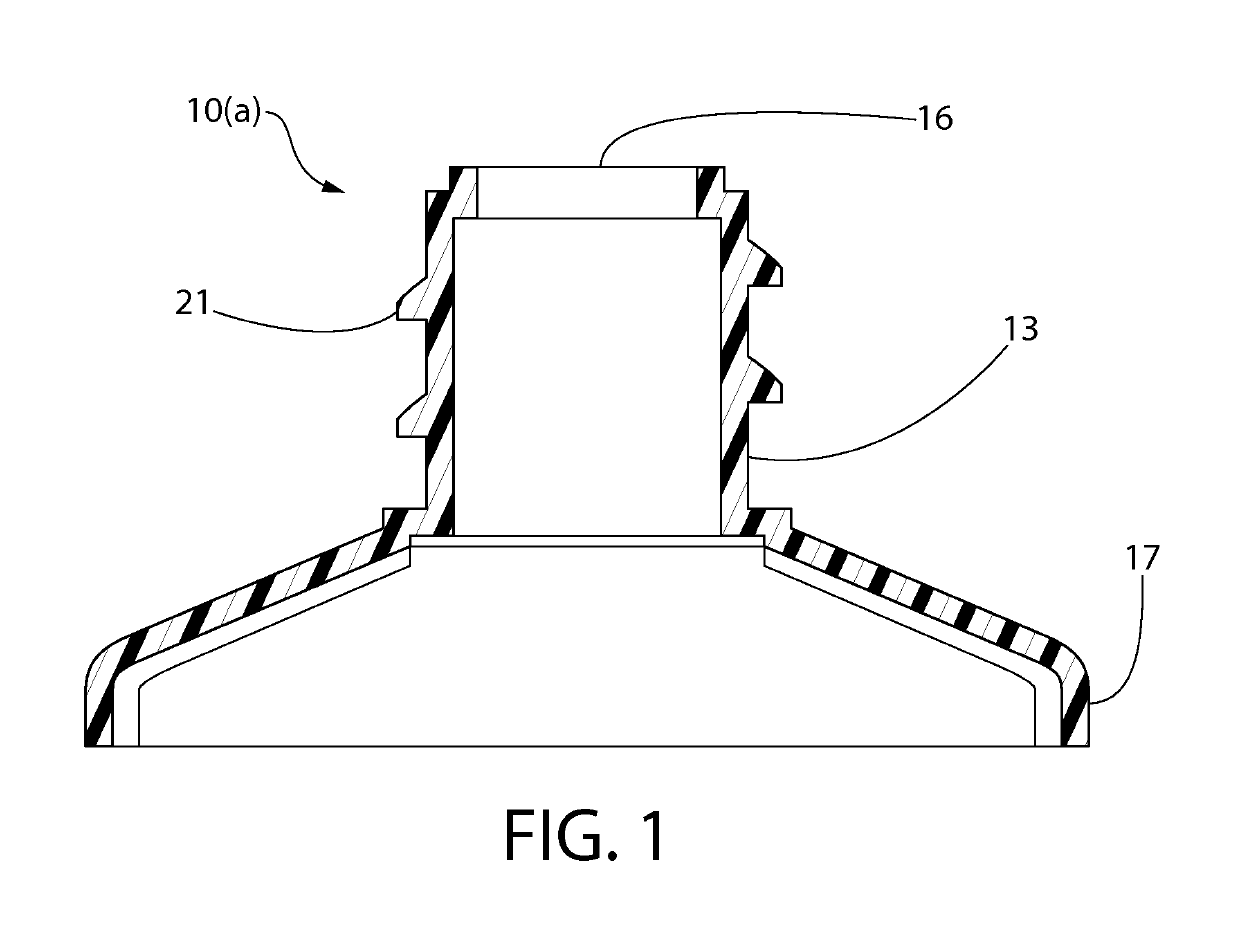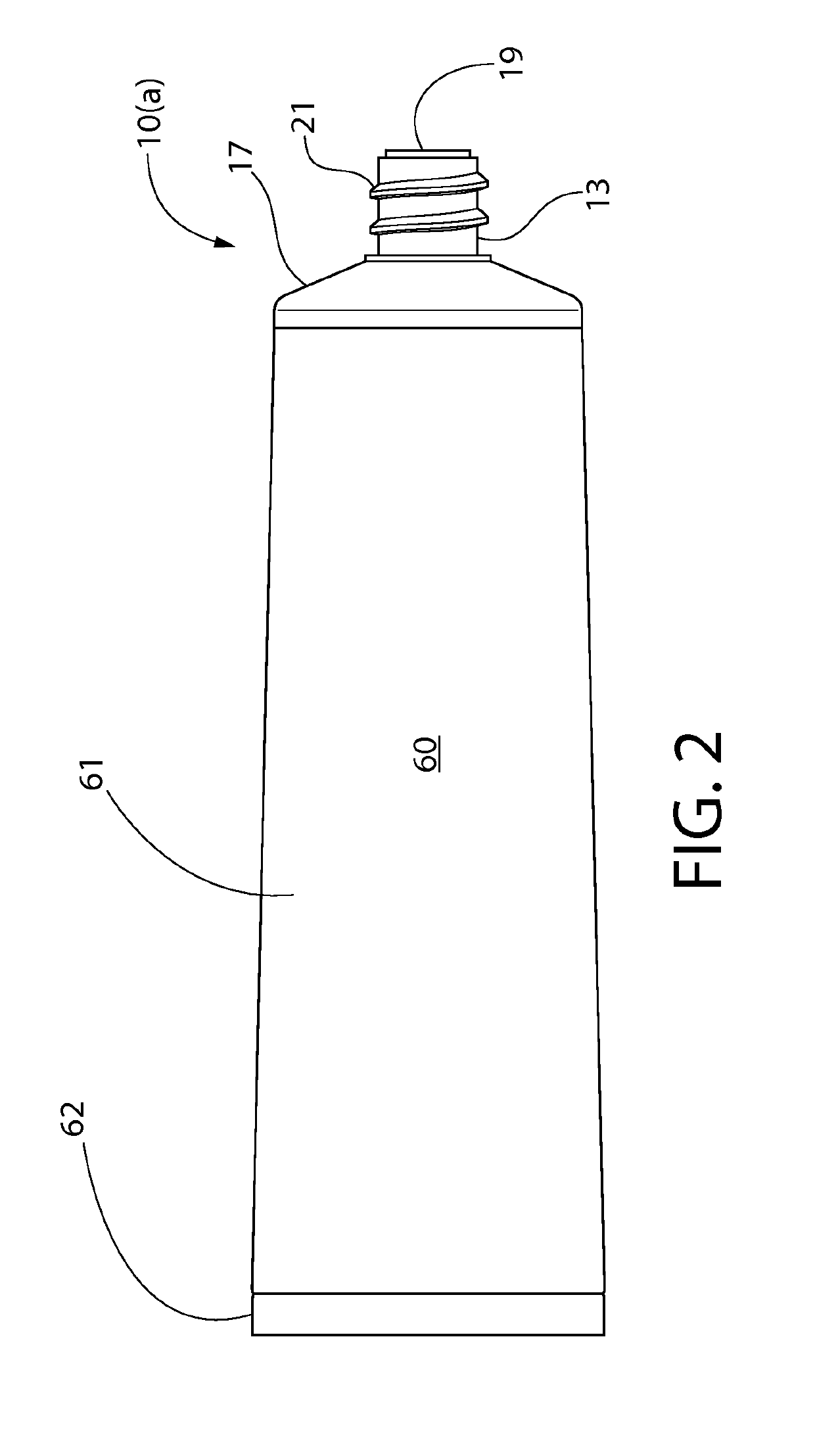Flavor Barrier Composition
a technology of flavor barrier and composition, which is applied in the direction of rigid containers, pliable tubular containers, transportation and packaging, etc., can solve the problems of insufficient ratio of barrier and antibacterial compound absorbing flavor and fragrance components, inaccurate barrier leads to good barrier, etc., to achieve high surface-to-volume ratio, material saving, and cost-effective
- Summary
- Abstract
- Description
- Claims
- Application Information
AI Technical Summary
Benefits of technology
Problems solved by technology
Method used
Image
Examples
example 1
Comparative Barrier Resins
[0034]HDPE was blended with COC, EVOH at ratios: 75 / 25 and 90 / 10, respectively. The diffusion coefficient (D) and the solubility (S) of the flavor molecules were measured and the permeability (P) was calculated by P=D×S. Two flavor molecules, i.e., limonene, anethole, were used.
[0035]Results for limonene are shown in Table 1 below and represented in the graphs of FIGS. 3A-3C while those for anethole are shown in Table 2 below and represented in the graphs of FIGS. 4A-4C.
[0036]FIG. 3C and FIG. 4C show that both EVOH and COC provide lower permeability as compared to HDPE, but via different mechanism. EVOH reduced both D and S, and COC reduced the D quite a lot but increased S.
TABLE 1Limonene Diffusion (D), Solubility (S) andPermeability (P) CoefficientsD × 109S × 102P × 1010Composition (Wt)(cm2 / s)(g / cm3)(g cm / cm2 s)HDPE9.8 ± 1.33.38 ± 0.123.33 ± 0.54HDPE / EVOH (90 / 10)10.0 ± 1.7 2.98 ± 0.192.99 ± 0.66HDPE / EVOH (75 / 25)9.6 ± 1.12.48 ± 0.092.37 ± 0.27HDPE / COC (90 / ...
example 3
Exemplary Barrier Material
[0037]A tri-component blend of HDPE / EVOH / COC was used to provide a good barrier material for flavor protection. The amount of EVOH was selected to be in the range of about 5 wt % to about 20 wt %, the amount of COC was selected from the range of about 5 wt % to about 20% wt %, and the amount of HDPE was selected from the range of about 60 wt % to about 90 wt %. For example, resins of HDPE, EVOH and COC were first dry mixed according to the weight percentages described above, along with a 2 phr (parts per hundred) white pigment masterbatch. The mixed blend was then compounded at 230-270° C. in either a single-screw or a twin-screw extruder. The extrudant was pelletized and then fed into an injection molding machine with the multi-cavity molds of tube shoulders. The injection molding barrel temperature, hot runner temperature and mold temperature was set to 210-250° C., 200-240° C. and 10-30° C., respectively.
example 4
Barrier Material Testing
[0038]A blend comprising HDPE, EVOH and COC was used to obtain the maximum reduction of P of flavor molecules. For example, as shown in Table 3 and illustrated in the graph of FIG. 5, the flavor permeability in the blends decreased 40-80% from that in HDPE. At a HDPE / EVOH / COC blending ratio of 70 / 15 / 15, the permeability of limonene decreased two thirds, from 5.3×10−10 g cm / cm2 s to 1.8×10−10 g cm / cm2 s; at a lower usage of barrier resin, i.e., HDPE / EVOH / COC blending ratio of 86 / 7 / 7, the limonene permeability also decreased a little bit over 50%. The selected blends also minimize the scalping of polar compounds, e.g., triclosan, from the product formulations. The permeability (P) was calculated by the product of solubility (S) and diffusion coefficient (or Diffusivity, D), i.e., P=S·D. Both S and D were measured by the following sorption test:
[0039]The compounded materials were compression molded into films with a thickness of 300 microns. First, the film was ...
PUM
| Property | Measurement | Unit |
|---|---|---|
| volume | aaaaa | aaaaa |
| thickness | aaaaa | aaaaa |
| volume | aaaaa | aaaaa |
Abstract
Description
Claims
Application Information
 Login to View More
Login to View More - R&D
- Intellectual Property
- Life Sciences
- Materials
- Tech Scout
- Unparalleled Data Quality
- Higher Quality Content
- 60% Fewer Hallucinations
Browse by: Latest US Patents, China's latest patents, Technical Efficacy Thesaurus, Application Domain, Technology Topic, Popular Technical Reports.
© 2025 PatSnap. All rights reserved.Legal|Privacy policy|Modern Slavery Act Transparency Statement|Sitemap|About US| Contact US: help@patsnap.com



